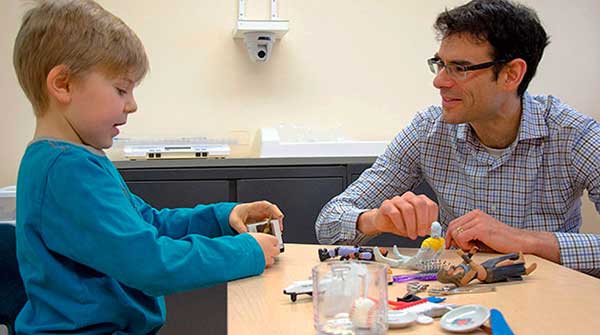New study unveils strategy to enhance social inclusion of kids with autism
A short and simple intervention that needs no specialized training to deliver could help encourage understanding and engagement with autistic children in recreational settings like day camps, according to a recent study led by researchers at the University of Alberta.

Sandra Hodgetts
Autistic children have a higher risk of experiencing social exclusion than children with other diagnoses, despite research showing that they do want to feel included, explains Sandra Hodgetts, the study’s lead author.
“It kind of comes down to the fact that we all want connection,” says Hodgetts, an associate professor in the Faculty of Rehabilitation Medicine and member of the Women and Children’s Health Research Institute.
Most other studies don’t evaluate inclusion simply because it’s a tough parameter to track, and there are many hypotheses of what it means.
 |
| Related Stories |
| Researchers detect early signs of autism in at-risk infants
|
| How Sesame Place is helping children with autism
|
| Three ways you can help families affected by autism
|
“For our study, we were really subscribing to a sense of belonging – someone belongs as they are, for who they are.”
Hodgetts and her collaborators also took a different approach with their intervention. Many existing interventions are focused almost solely on the autistic children and ways to alter their behaviour so they better “fit in” amongst their peers. The intervention within the study viewed peers’ lack of awareness and understanding about autism as equally important to target, explains Hodgetts.
“I think often we’re so focused on the autistic kids at school, camp, wherever, that we forget to use the peers. We overlook how capable peers are at stepping up.”
The intervention – a short script crafted in collaboration with the autistic children’s parents and some of the children themselves – needed no specialized training or qualifications to deliver.
“You don’t have highly trained researchers and health-care providers or educators everywhere that kids go in life,” says Hodgetts. “And kids deserve to be engaged with and included wherever they go.”
This also meant the same script used in the day camp could be adapted and used elsewhere, Hodgetts notes.
Each script had four main components. The word autism was specifically used, naming the diagnosis, and context was provided on characteristics and ways in which the autistic child may behave or communicate differently. It also incorporated the child’s strengths and interests so peers could recognize similarities, and offered peers specific strategies to engage.
For example, if a particular autistic child had a propensity to encroach too much on a peer’s space when they wanted to play, the script would include letting the peers know what that tendency to get too close meant from the autistic child’s perspective and how to best respond in a way that made everyone feel comfortable and included.
To gauge the intervention’s success, the researchers used an adapted version of the Playground Observation of Peer Engagement. Videos were captured of the interactions, and the researchers watched them in minute-by-minute increments, coding them with markers that indicated when the child was engaged with and included and when they weren’t.
The results showed that autistic campers within the intervention group had more instances of engagement with their peers. Additionally, Hodgetts highlights that there was a large effect size, indicating that the intervention could have a big impact.
“An effect size is a statistic that essentially lets you know if the change you see is clinically meaningful.”
With this study, Hodgetts and her collaborators observed 15 children in a week-long day camp. Next steps involve a partnership with the Edmonton Catholic School District to implement a version of the intervention in schools.
“That’s important because schools give so much more opportunity to really build that authentic friendship and inclusion piece that a five-day summer camp just didn’t have.”
Hodgetts has already received feedback from one study participant who successfully used the script in another recreational context, showing promise for its wider applicability.
“Our focus doesn’t need to be to ‘normalize’ kids to fit into our preconceived notion of what behaviour or participation should look like,” she says.
“I think letting kids be who they are and just using the differences and strengths and helping their peers understand has great outcomes for everyone.”
| By Adrianna MacPherson
This article was submitted by the University of Alberta’s Folio online magazine, a Troy Media Editorial Content Provider Partner.
The opinions expressed by our columnists and contributors are theirs alone and do not inherently or expressly reflect the views of our publication.
© Troy Media
Troy Media is an editorial content provider to media outlets and its own hosted community news outlets across Canada.

